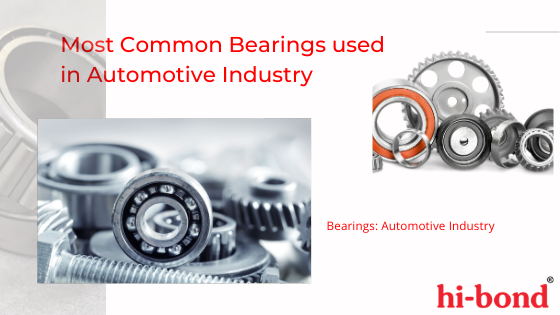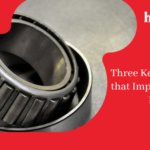No automobile can function without a bearing. Likewise, bearings act as a fulcrum in the automotive industry.
From wheel rotation to transmission, bearings are always present. If you want to steer the vehicle, you make use of a bearing. Do you want to shift gears? — Bearings are a must.
Though they are found in the majority of the machines, not every bearing is easily visible. Working in the shadows, these tiny mechanical parts have grown into being the ‘bread and butter’ of the automobile industry. Every rotation or load carry employs some kind of bearing. A bearing manufacturer must be proud of this appreciation.
Marching forward, let us now understand briefly why they are important in the automobile industry.
-
Reduce Friction
Any movement that involves two surfaces that are in contact experiences an opposing force i.e. Friction. This hampers the efficiency of the machinery. While increasing the potential for jarring, friction also means mechanical parts need constant repair and replacement.
But, bearings solve this problem. Using lubricants, bearings reduce friction by leaps and bounds. A well-cleaned and lubricated bearing can last a substantial amount of time.
For example, Journal bearing is used to support crankshafts.
-
Withstand load and Guide movement
Bearings assist in the absorption of voluminous amounts of load. It absorbs the force and concentrates the same towards the smooth movement. Likewise, bearings double up as guides for machines to follow. Bearings direct the movement and ensure components move in the desired direction. This also protects the fragile components from frequent wear and tear.
For example, Flange bearings are used for automobiles to withstand high axial loads and vibrations.
These are two basic, yet profound reasons why bearings are used extensively in the automotive industry. These reasons also assure that bearings are indispensable.
Moving on, we will look at the most commonly used bearings in the automotive industry. Surely, you would have seen a plethora of options on the website of a bearing manufacturer. Flange bearings, journal bearings, bush bearings are all specific types of bearings. But, which are the most common bearings? Read along.
-
Plain bearings
A bearing manufacturers’ favorite — Plain bearings. It is used in the automotive industry at scale. It is a mechanical component that allows for smooth motion between two parts of a machine. Simple, right? However, it also prevents wear and tears at all junctures where the shaft would have rolled in direct contact with the machine.
It is manufactured using materials with a low friction coefficient. The lubricants are also vetted and picked to reduce the friction as much as possible. This ensures a significant increase in the machine’s lifespan.
There are many types of plain bearings.
With regards to the lubrication requirements, it is divided into four types:
- Self-lubrication bearings,
- Regularly lubricated bearings,
- Hydrostatic bearings,
- Hydrodynamic bearings.
Certain key advantages of using plain bearings are:
- They are adept at managing both static and dynamic loads,
- These allow for higher rotational speeds,
- Inexpensive, yet have a long operable life,
- Accommodates misalignment and deformation of surrounding components.
-
Rolling element bearings
These types of bearings see high demand in the automotive industry. The rolling element means these bearings have two rings inside of them. These facilitate high rotational speeds with negligible rolling resistance.
Ball bearings and rolling bearings are the ones that constitute the totality of rolling element bearings.
While ball bearings handle both axial and thrust loads efficiently, it fails at handling heavier loads. The two rings (races) often tend to deform, under heavy loads.
But, rolling bearings can withstand a heavier radial load. Using cylinder-like components, rolling bearings spread the load over a large area. This results in a very stiff bearing. Hence, this is often used in areas that are prone to shaft deflections or misalignment.
Like plain bearings, even rolling bearings are of different types. Some of the most common are:
- Cylindrical roller bearings,
- Tapered roller bearings,
- Deep groove ball bearings,
- Thrust ball bearings.
Advantages of using rolling bearings are:
- Low starting and operating friction,
- Accuracy of shaft alignment,
- There is no need for lubrication,
- Radial and thrust load is withstood simultaneously,
- Reliable precision and long life.
-
Magnetic bearings
Using magnetic levitation, these bearings withstand load and ease movement. These bearings have an upper-hand over other bearings as lubrication is not required. This means reduced friction. As magnetic bearings can work efficiently in a vacuum, they are growing in popularity. Alongside, there is negligible scope for physical contact between the solid surfaces.
These bearings that work on electromagnetic forces are highly reliable. They rarely experience wear and tear.
Magnetic bearings also provide two operable options. The first one being ‘passive’ in which the magnetic bearing works using permanent magnets or reluctance forces. The other option is ‘active’ where electromagnets are employed. They are further controlled using electronic systems. This facet of flexibility has been a revelation of sorts in the automotive industry.
One concern about magnetic bearings is the fact that they require consistent power input. This acts as a prerequisite to keep the load stable. In the case of an electronic system or power failure, a backup is mandated.
Nowadays, these magnetic bearings are being used at scale. From generators and motors to gas and steam turbines, magnetic bearings are growing in relevance.
Alongside the passive and active magnetic bearings, there are few other types.
- Radial magnetic bearings,
- Thrust or Axial magnetic bearings,
- Auxiliary bearing (backup).
The following advantages reflect the upper hand, magnetic bearings have on other types of bearings.
- Improved safety,
- Virtually maintenance-free,
- Noise emissions are reduced significantly,
- Oil-free and energy-efficient,
- Comparatively cheaper, in the longer run,
- Better hands-on control over the rotor dynamics.
Investing in an experienced bearing manufacturer for quality bearings is the way to proceed. With competition growing, innovation is a must.
What if experience and innovation foregathered for your benefit? It is known by the name — Hi-bond. Market leaders for 30 years are one call away. Click here




